Mulberry in the Moscow region: proper cultivation of mulberry
Mulberry - a plant that gives tasty and healthy fruits. But it can be grown without problems only in the southern regions. She is afraid of frost. But now more and more mulberries are grown in the middle lane, including the Moscow region, and even in Siberia.
Content:
- Mulberry: description
- Mulberry use
- Mulberry varieties for the Moscow region
- Mulberry propagation
- Planting a seedling
- Care Tips
Mulberry: description
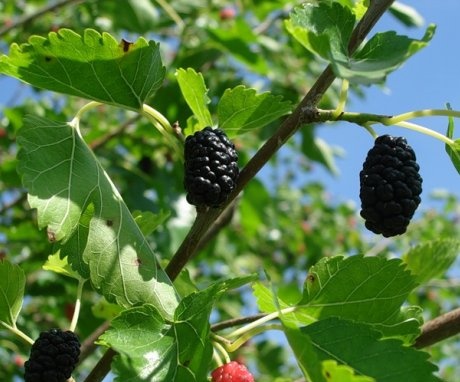
Mulberries are fleshy polydrupes. Their color can be white, pink, purple, dark purple. The size ranges from 1 to 5 cm, depending on the variety. In the southern regions, non-varietal trees are almost everywhere. But their fruits can be large and delicious. There are male and female specimens.
Mulberry has another name - mulberry tree or mulberry tree.
Mulberry blossoms later than other fruit crops. But its fruits ripen earlier than many of those that bloom in early spring. Spring return frosts can be a problem when growing mulberries. Part of the leaves, and sometimes all of them, after the temperature drops to -1 ° C, turn black and disappear.
True, the tree itself almost never dies in this case. New shoots and leaves grow. A few weeks after the frost, the mulberry crown turns green, as if nothing had happened. But the fruits for which the mulberry is grown may not remain. Flower buds that have been affected by frost will not recover. If the cold snap was insignificant, only part of the crown may suffer. Especially the one that was affected by the currents of frosty air.
A mulberry tree with good snow cover can withstand temperatures as low as -30 ° C. But, if there is little or no snow at all, the roots of the plant may freeze. The tree will weaken and may die. This can happen even when the temperature drops to -7 ° C.
Mulberry use
The composition and use of berries in medicine:
- Mulberries are used in folk medicine to treat bronchitis, asthma and bowel problems. Ripe ones are used for constipation. They have a laxative effect. If you need to stop diarrhea, eat ripe berries.
- They contain many vitamins of groups A, B, C and E, folic acid, macro- and microelements, including a lot of potassium, calcium, magnesium, phosphorus, copper, manganese. The fruit contains selenium, which has a beneficial effect on the functioning of the thyroid gland.
- It is low in calories, in 100 g of fruits there are only 43 kcal.
- Mulberry fruits have a diuretic and choleretic effect, remove inflammatory processes. They are recommended for use in diseases of the cardiovascular system, they reduce shortness of breath and pain in the heart. But to achieve the result, you need to eat a lot of fresh fruits for a long time.
- Rinse the mouth with mulberry juice to treat stomatitis and heal wounds of other origins.
- Mulberry juice or compote is used for colds as a diaphoretic.
Not everyone will benefit from mulberry fruits. Patients with hypertension need to use them carefully. It can build up blood pressure, especially at high temperatures. With diabetes mellitus, you can not eat a lot of mulberries.
Mulberry varieties for the Moscow region
The selection of suitable varieties is of great importance for the successful cultivation of mulberries. The following varieties are best suited for this region:
- "Vladimirskaya" with red fruits about 3 cm long. Fruit color is dark purple. The tree naturally grows up to 6 m in height. If the conductor is cut closer to the ground, it will take the form of a bush. If cut at a height of one and a half meters, the mulberry will become similar in shape to a weeping willow. This will make harvesting easier and give the tree its original shape. The variety is frost-resistant, does not require pollinators.
- "Royal" is a tree of medium height. The fruits are very sweet and tasty. Quite large, the length of one is about 3 cm. The advantage of the variety is high yield and frost resistance. For the winter, you do not need to shelter it even in the Moscow region. The fruits can be transported long distances. The variety is resistant to diseases and pests mulberries. The fruits and bark are used in traditional medicine. The disadvantage is partial self-pollination. The cultivar needs pollinators of a different cultivar.
- "White Honey" is frost-resistant, high-yielding, with tasty fruits. It can be grown on any soil. The disadvantage is the short shelf life of the berries. They can be stored for about 6 hours.
- "Black Prince" is a plant with large fruits about 5 cm in size. It can grow on any soil, frost-resistant, does not require watering. The disadvantage is that the variety is not self-fertile, requires pollinators.
- "Staromoskovskaya" with sweet black fruits up to 3 cm long. The tree can reach a height of up to 10 m.
- "Black Baroness" got its name for its large berries, the length of which reaches 4 cm. The variety is frost-resistant, high-yielding. Disadvantages: the fruits are stored plucked for only 12 hours, the variety is partially self-fertile.
Some mulberry trees bloom profusely with large shaggy flowers, but do not bear fruit at all. These are the so-called "silkworms" that pollinate female trees.
Mulberry propagation
There are several ways to get a mulberry tree:
- Seeds, pre-stratified 1.5 months in the cellar or refrigerator. You can sow them directly into the ground before winter.
- Root processes.
- Layers dug into the ground.
- Cuttings, preferably green, with 4-6 leaves. The lower ones are removed, the upper ones are cut in half. They are planted in a greenhouse under a film, after a month and a half they should take root. Lignified cuttings take root for a month longer. Before planting in the substrate, they must be treated with Kornevin. Seedlings are harder and stronger than cuttings. But parental properties are not always transmitted through seeds.
- Vaccination one grade to another. White mulberry is used as a stock. This method allows you to get the harvest much earlier. The specific features of the variety are preserved. Sometimes several varieties of different colors of leaves and fruits are grafted onto one stock.
Planting a seedling
Prepare a pit for mulberries in advance, at least two weeks before planting. It is better to do this in the fall. The depth of the pit is 1 m, the diameter is 1 m. The topsoil is laid on the side. The bottom is taken out, mixed with humus, a glass is added wood ash.
The prepared soil is poured into the pit so that it settles down. This supply of nutrients will help the plant grow rapidly for several years. In the spring, the seedling is placed in a pit.
Given the fact that mulberries are afraid of frost, it is recommended to deepen the root collar by a couple of centimeters when planting.
Watered, covered with a harvested layer of earth. The near-trunk circle is mulched with a layer of humus, peat or grass at least 5 cm thick. The mulberry needs regular watering until its root system is able to provide the tree with a sufficient amount of moisture.
Care Tips
Mulberry has two growing seasons. Its shoots grow in spring and autumn.During the period of spring and even summer cold snap, some of them, affected by frost, die off. In their place, new shoots bloom next year.
Growing methods:
- In the Moscow region, mulberries can be grown in the form of a bush. The crown is formed so that the plant has several trunks. The bush is easier to wrap up from frost than a tall tree.
- When growing mulberries in the form of a tree, forming pruning is carried out in the first years of life. For this, a conductor and several side branches are left. In an adult tree that has reached 6 years of age, the "extra" branches die off by themselves. But you need to cut them off regularly.
Once every 4 years, the branches can be thinned out, and the shape of the crown can be corrected. This is best done in late autumn. In summer and late spring, they are not pruned, because young shoots will not ripen by autumn and will die. The mulberry bush should be well lit by the sun all day. Therefore, it must be planted so that tall trees do not shade it. They should be located at a distance of 7 m from the mulberry.
If the mulberry was planted correctly, then in the first 3 years it is not fed. It uses the nutrients introduced during planting. Fertilizing mulberries can be omitted. But the tree responds well to the introduction of nitrogen fertilizers in the spring, and potash and phosphorus fertilizers in the fall. The plant is watered, then mulch.
In autumn, a young mulberry tree is covered with a non-woven material.
The trunk circle is mulched with straw, spruce branches. This will protect the root system from frost. If the branches are frozen, they quickly recover. Mulberry is sick relatively little. There are even fewer such cases in the northern regions. For example, such a dangerous disease as bacterial wilting is common only in the south. In the Moscow region, mulberry can be affected by leaf spot. This is a fungal disease, so you can fight it with fungicides containing copper. The crown is thinned out before processing. This will improve ventilation inside it and make it easier to access the branches.
More information can be found in the video:



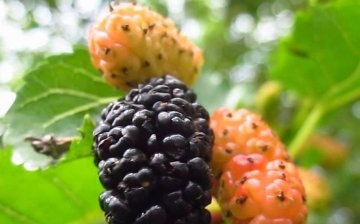


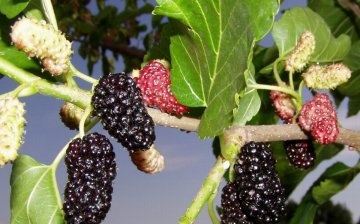
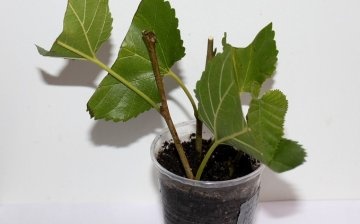
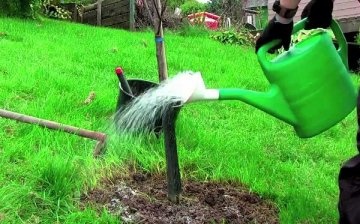
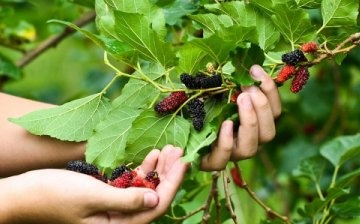







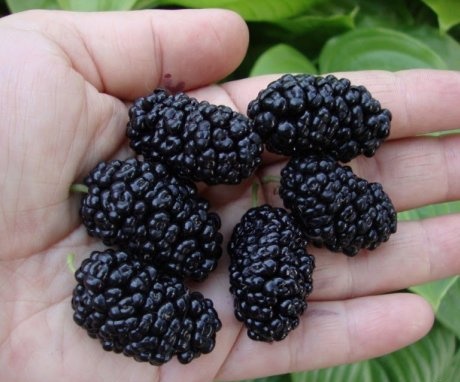
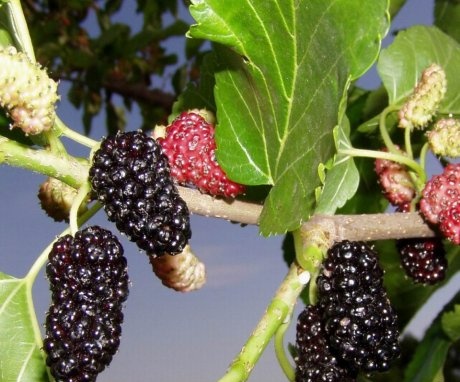
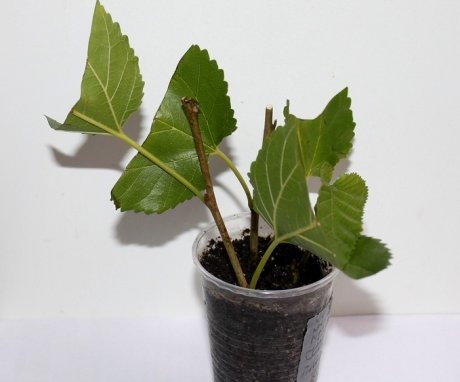


Our dark red mulberry grows very well. In winter, it does not freeze. Caring for this tree is quite simple, we dig up the trunk circle, and in late autumn we do the crown pruning. Mulberries are delicious and they lower blood pressure.